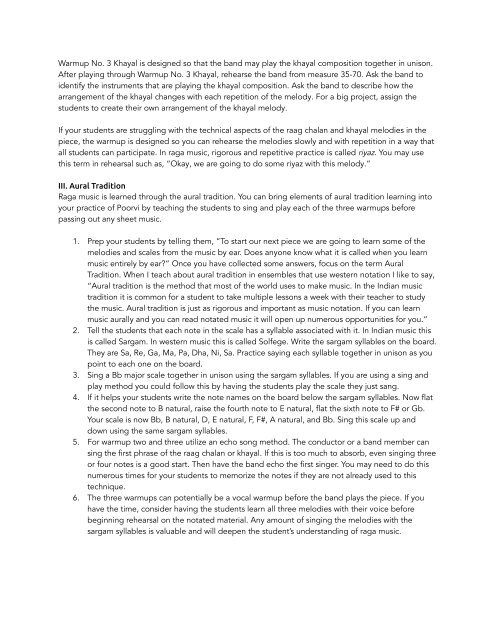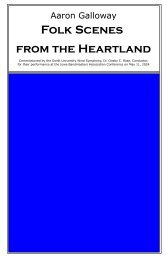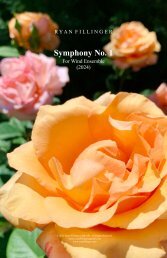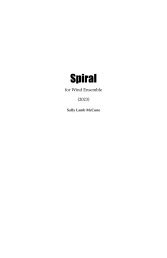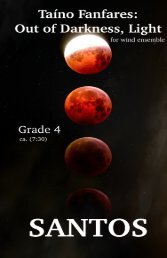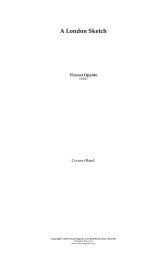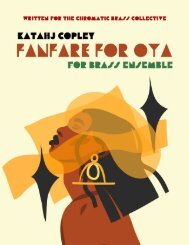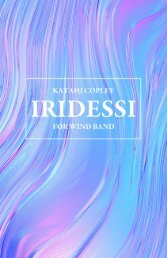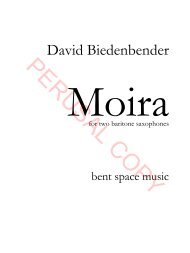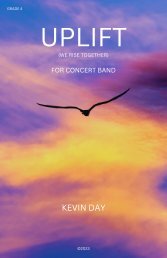You also want an ePaper? Increase the reach of your titles
YUMPU automatically turns print PDFs into web optimized ePapers that Google loves.
Warmup No. 3 Khayal is designed so that the band may play the khayal composition together in unison.<br />
After playing through Warmup No. 3 Khayal, rehearse the band from measure 35-70. Ask the band to<br />
identify the instruments that are playing the khayal composition. Ask the band to describe how the<br />
arrangement of the khayal changes with each repetition of the melody. For a big project, assign the<br />
students to create their own arrangement of the khayal melody.<br />
If your students are struggling with the technical aspects of the raag chalan and khayal melodies in the<br />
piece, the warmup is designed so you can rehearse the melodies slowly and with repetition in a way that<br />
all students can participate. In raga music, rigorous and repetitive practice is called riyaz. You may use<br />
this term in rehearsal such as, “Okay, we are going to do some riyaz with this melody.”<br />
III. Aural Tradition<br />
<strong>Raga</strong> music is learned through the aural tradition. You can bring elements of aural tradition learning into<br />
your practice of <strong>Poorvi</strong> by teaching the students to sing and play each of the three warmups be<strong>for</strong>e<br />
passing out any sheet music.<br />
1. Prep your students by telling them, “To start our next piece we are going to learn some of the<br />
melodies and scales from the music by ear. Does anyone know what it is called when you learn<br />
music entirely by ear?” Once you have collected some answers, focus on the term Aural<br />
Tradition. When I teach about aural tradition in ensembles that use western notation I like to say,<br />
“Aural tradition is the method that most of the world uses to make music. In the Indian music<br />
tradition it is common <strong>for</strong> a student to take multiple lessons a week with their teacher to study<br />
the music. Aural tradition is just as rigorous and important as music notation. If you can learn<br />
music aurally and you can read notated music it will open up numerous opportunities <strong>for</strong> you.”<br />
2. Tell the students that each note in the scale has a syllable associated with it. In Indian music this<br />
is called Sargam. In western music this is called Solfege. Write the sargam syllables on the board.<br />
They are Sa, Re, Ga, Ma, Pa, Dha, Ni, Sa. Practice saying each syllable together in unison as you<br />
point to each one on the board.<br />
3. Sing a Bb major scale together in unison using the sargam syllables. If you are using a sing and<br />
play method you could follow this by having the students play the scale they just sang.<br />
4. If it helps your students write the note names on the board below the sargam syllables. Now flat<br />
the second note to B natural, raise the fourth note to E natural, flat the sixth note to F# or Gb.<br />
Your scale is now Bb, B natural, D, E natural, F, F#, A natural, and Bb. Sing this scale up and<br />
down using the same sargam syllables.<br />
5. For warmup two and three utilize an echo song method. The conductor or a band member can<br />
sing the first phrase of the raag chalan or khayal. If this is too much to absorb, even singing three<br />
or four notes is a good start. Then have the band echo the first singer. You may need to do this<br />
numerous times <strong>for</strong> your students to memorize the notes if they are not already used to this<br />
technique.<br />
6. The three warmups can potentially be a vocal warmup be<strong>for</strong>e the band plays the piece. If you<br />
have the time, consider having the students learn all three melodies with their voice be<strong>for</strong>e<br />
beginning rehearsal on the notated material. <strong>An</strong>y amount of singing the melodies with the<br />
sargam syllables is valuable and will deepen the student’s understanding of raga music.


